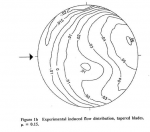I have been traveling, so it was just too hard to continue participation on this topic until now.
Back in the good old days when I was doing a lot of experimenting with gyroplanes, I had to find ways to make the gyroplane more efficient to use the smaller Rotax engines. As many of you old-boys will remember, I demonstrated some of these experiments at the air shows, like using smoke in front of the gyroplane to demonstrate how the airflow fed the propeller, and its exit points.
I also did rotorsystem experiments. I took about 2 foot of red yarn and taped it to my wheel-pants on my 532 Commander Elite and allowed it to stream behind as I observed it while fly close to the ground. Now, if there were any ground effect, you could see the yarn pulsating up and down to the beat of the rotors. No matter how slow and low I flew, the yarn didn’t deviate from the airstream whatsoever, until I landed and the airflow revirced through the rotors.
I continued to experiment further, and I took another 1.5 foot length of red yarn and tied it to the end of a thin bamboo stick, where I could reach out to inside the outer ¾ of the disk. I would take off with the bamboo sticking forward in a small tube to hold it, and then as flying at different speeds, I could remove the bamboo in my throttle hand and hold it up to the rotors. Only until I got the yarn about a foot from the rotor disk could I see any pulsation. Even while landing there was absolutely no pulsation below about a foot from the disk, until again the air reversed and then there was the downwash.
I’m sure everyone remembers my 447 Commander promotion video. You remember me hovering into the wind and flying sideways over the tall vegetation. I continued to experiment in my heavier 532 Commander Elite by flying as close to the tall grass as possible, and as slow as possible while maintaining level flight so not to point the nose into the air and hang in the prop. There was never any grass being disturbed under my disk. But, there was disturbance behind me, so there are vortices reaching the ground, but not under the disk.
Then, I would fly over the grass low, slow and at a nose high attitude. The prop-blast disturbed the grass, and the closer I got to the ground, the wider the pattern of disturbance became, but always well behind my axles, in fact about even with my tail wheel.
Those were my personal observations on the matter.

